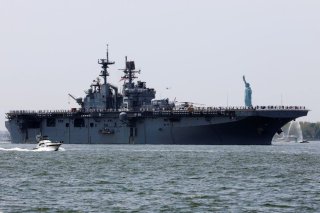What If the Navy's Assault Ships Also Carried a Boat-Load of Missiles?
Is that even a good idea?
Key point: These warships allow the Marines to land and do their thing. But what if they could also pack a big punch?
It’s no secret. The U.S. Navy can’t afford all the ships it wants. At the same time, China’s deployment of hundreds of long-range anti-ship missiles threatens to render obsolete the ships the Navy already does have.
These twin problems weigh heavily on the Navy’s amphibious force, which transport, lands and supports U.S. Marines. One solution that officials are mulling is to form a larger number of amphibious groups by adding small support vessels and arming the traditional assault ships at the heart of each group.
Money is an inescapable problem. The Navy and Marine Corps are struggling to afford the 38 amphibious assault ships that the Navy said it needed following its last formal force-structure assessment in 2016.
In late 2019 the fleet operated 32 amphibs, including nine big-deck assault ships that, with large contingents of F-35B jump jets, can double as light aircraft carriers. The fleet of “L-class” amphibious ships also included 11 landing platform ships, or LPDs, that can carry people and landing craft plus 12 landing dock ships, or LSDs, that mostly carry cargo.
The Navy’s current goal is to boost the L-class fleet to 12 big-deck assault ships and 13 each LPDs and LSDs.
But that could cost $75 billion over 30 years and would do nothing to change the Navy’s tendency to concentrate its capabilities in a relatively small number of big, expensive ships. That concentration leaves the fleet vulnerable to Chinese missile barrages.
The Navy and Marines are preparing an alternative force-structure assessment that, when it arrives some time in late 2019, could call for a bigger amphibious force including smaller and cheaper vessels.
In recent years the Navy and Marines have experimented with using cargo ships as amphibious platforms. One Navy official proposed that the Navy adopt, as a cheap amphib, a version of the small Offshore Support Vessel that the oil industry uses to maintain oil platforms.
Speaking at a defense industry event in Maryland in mid-October, Capt. J.R. Hill, the amphibious warfare branch head within the Navy’s expeditionary warfare directorate, said the Marine Corps will endorse adding a new small ship type to supplement the current amphibious ships.
“The two services are happy with the America-class amphibious assault ships and San Antonio-class amphibious transport docks as ship designs that will support their operations now and into the future,” Megan Eckstein wrote for USNI News. “But the service is also looking at something smaller than today’s Whidbey Island-class dock landing ship but larger than a landing craft utility to complement the America and San Antonio classes.
Capt. Brian Metcalf, the San Antonio-class program manager, asked the audience at the same event to imagine a different construct than the three-ship amphibious ready group, or ARG, that currently dominates Navy and Marine force-planning. An ARG typically includes one big-deck assault ship, one LPD and one LSD in order to land and support a Marine battalion.
“We have defined, unfortunately, the ARG as a combination of one each of those three ships for entirely too long,” Metcalf said. “Now, what if I could describe to you an amphibious readiness group that was an LPD with four [Littoral Combat Ships]? Two of them outfitted with mine packages, two of them with surface-to-surface weapons?”
“Does that sound like an amphibious readiness group?” Metcalf added. “It’s not the traditional definition, but could it go do amphibious missions? Two [hovercraft] on the back of an LPD, with four LCSs. Does that sound like something a [combatant commander] might look for, that could accomplish a mission?”
The Navy, in theory, could form small amphibious groups around single LPDs, each capable of landing a few companies of Marines. Round out the group with inexpensive support ships and escorts, and the fleet might discover a useful capability that’s cheaper than the current ARG and helps it to spread out its forces to better avoid Chinese missiles.
But it might help to arm the LPD, Maj. Gen. Tracy King, the Marines’ expeditionary warfare director, said at the Maryland event.
“King noted that LCSs are fast, and are much more lethal now that the Naval Strike Missile is being added to the hulls,” Eckstein reported. “Further, he noted, an amphib is a warship and must be able to fight other warships, and to that end he suggested adding the Naval Strike Missile to amphibious ships as well. Previously the idea of adding Vertical Launching System cells to the LPDs had been debated but is largely viewed as unattainable in this budget environment.”
“Do we need something like a Naval Strike Missile so the composite warfare commander calling on the cruiser, calling on the DDG-51, can use that magazine? Absolutely. And we’re going to try to do that, but it is a budgetary fight,” King said.
David Axe served as a defense editor for the National Interest. He is the author of the graphic novels War Fix, War Is Boring and Machete Squad. This article was first published in 2019.
Image: Reuters

